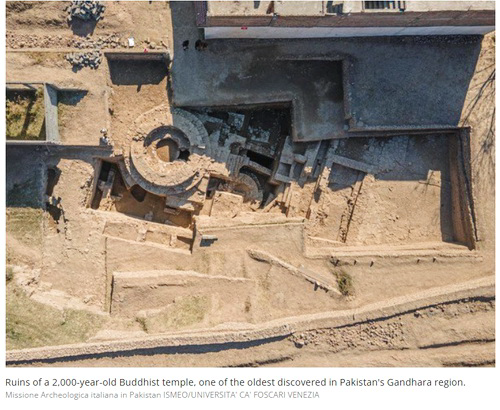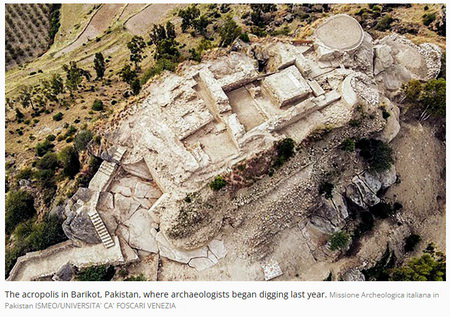Tin vui cho đạo Phật mới hôm qua
15 Feb 2022
Nhóm khảo cổ thuộc dòng Catholic Khảo Cổ ( Missione Archeologica Italiana ) tại Pakistan vừa khám phá một ngôi Chùa Phật giáo xưa nhất tại Pakistan .

Người ta đào xới vùng thung lũng Swat Valley ( Tây Bắc Pakistan ) một di tích lớn Chùa Phật giáo tại đây. Tuổi thọ của ngôi chùa nầy trên 2000 năm ( theo tin tức nhật báo HIndustan Times tại Ấn Độ )
Nằm trong thị trấn Barikot , di tích nầy được định là vào khoảng Thế kỷ thứ nhì trước Công nguyên .
Di tích nầy có lẽ được xây dựng sau khi Đức Phật ( Siddharta Gautama ) nhập Niết Bàn vài trăm năm sau.
Nhà khảo cổ " Luca Maria Olivieri " thuộc đại học " Cá Foscari University xứ Venice , chủ đạo trong chương trình khảo cổ tại Pakistan thuộc dòng tu Catholic mang tên " The International Association for Mediterranean and Orieltal Studies ( ISMEO ) .
Chương trình đào xới , khảo cổ tại vùng Gandhara nầy được lịch sử vùng thương mãi và văn hóa giữa Ấn , Trung Á và Trung Đông .
Ấn giáo ( Hindu ) , Buddhist ( Phật Giáo ) và vương triều Ấn- Hy ( India- Greek Rulers ) thay nhau đỗi chủ tại vùng thương mãi + văn hóa quan trọng Gandhara suốt từ Đệ nhất thiên niên kỷ ( First Millenium B.C.E ) ( nghĩa là ngôi chùa Phật nầy có mặt thời Đệ Nhị Millenium trước vương triều Ấn-Hy ( India-Greek Rulers ).
Ngôi chùa Phât nầy có sân làm lễ nghiêm trang thờ Phật , sau đó là những phòng cư trú cho tăng ni , ...cột trụ , hành lang , bậc thang , phòng thiền và nơi tham quan cho công chúng , ngó ra vườn hoa cây cỏ khá rộng rãi...
Nhà khảo cổ " Luca Maria Olivieri " cho rằng vùng Swat Valley nầy chính là nơi quan trọng và trang nhiêm , thịnh trị của đạo Phât thuộc suốt vùng Gandhara thuộc Pakistan.
Ngoài ra đoàn khảo cổ còn tìm được tiền vàng , trang sức , hình tượng , ấn chỉ , đồ gốm thông dụng trong nhà ....

Sở dĩ Chùa Phât Barikot / Pakistan nầy bị bỏ hoang là có lẽ sau đó chừng vài trăm năm có cuộc động đất rất lớn vào hướng Bắc Gandhara Pakistan....
Danh từ Barikot được lịch sử Hy - La ( Greek- Roma ) gọi là " Bazira = Beira ".
Trước đó ngươi ta lầm , cho rằng khu vực Phật Giáo nầy thịnh hành vào thời gian Đại đế " Alexandre the Great " xâm lăng Pakistan và Bắc Ấn ( khoảng năm 327 B.C.E ) , nay người ta tính lại là ngôi chùa Phật nầy có trước gần nghìn năm trước Công Nguyên , sau Đức Phật nhập Niết Bàn vài trăm năm sau.
Sau khi Đại đế " Alexandre the Great " mất vài năm , thì lảnh thổ mà Hy Lạp chiếm được bị phân chia bởi những đại tướng của Đại đế " Alexandre the Great ".
Thời ký đó tỉnh Gandhara thuộc vương triều Mauryan Empire thuộc Ấn .
Vương triều nầy kéo dài từ năm 321 đến 185 B.C.E ( B.C.E = Before Common Era = Trước Công Nguyên = Jesus ra đời )
Nhóm khào cổ Venice nầy thuộc dòng Catholic Vatican khảo cổ , Họ đào xới tại Pakistan nầy từ năm 1955 ...
Nhóm nầy đào được một con đường quốc lộ thời đó , Họ gọi là con đường của Chùa chiền miếu mạo ( Street of Temples )
Theo tuần báo nổi tiếng " Live Science Magazine " thì đạo Phật được trở lại thịnh trị lần nữa vào thời Vua Menader I ( khoảng 150 B.C.E ).
** Vua Menader I gốc Ấn - Hy...
Ông theo đạo Hindu nhưng sau khi vấn đáp với tỳ kheo " Nagasena " và Vua Minida ( Menader King ) ...ra bộ kinh vấn đáp thuộc dạng trí tuệ suy tư của đạo Phật...
Đó là Bộ Kinh " Milinda Panha " ( Kinh Mi Tiên Vấn Đáp ).
Muốn tìm hiểu đạo Phật sâu xa thì Phật tử phải nên đọc + hiểu lời hỏi của Vua Minida = Menader I ) và câu trả lời của tỳ kheo Nagasena .
.png) .png)
Kinh Mit tiên vấn đáp đã khai ngộ vị minh quân người Ấn-Hy vương triều tại Bắc Ấn.
Vua Menader I = King Minda sau khi được tỳ kheo Ni Tiên trả lời , Vua liền tu theo đạo Phật và mong mọi thần dân của Ngài theo đạo Phật.
Vua cho trùng tu nhiều chùa chiền...đao Phật rất hưng thịnh tại lảnh thổ Pakistan nầy...
Thời gian hưng thịnh nầy được lịch sử gọi là " Greco-Buddhist " , chùa chiền Phật Giáo được xây dựng bởi những kiến trúc sư Hy Lạp + Ấn tạo nên một phong cách Chùa Phật Ấn mang kiến trúc hạ tầng khoa học theo Hy Lạp...( nghĩa là sảnh dường khang trang , rộng mát và trước sân có vườn hoa cắt tỉa gọn, đẹp mắt. ,có hồ nước chảy song song ..)
*
2,000-Year-Old Buddhist Temple Unearthed in Pakistan
The structure is one of the oldest of its kind in the Gandhara region
David Kindy
Daily Correspondent
February 15, 2022 9:03 a.m.
circular and square-like structures in the sand
.jpg)
Ruins of a 2,000-year-old Buddhist temple, one of the oldest discovered in Pakistan's Gandhara region. Missione Archeologica italiana in Pakistan
Archaeologists in northwest Pakistan’s Swat Valley have unearthed a roughly 2,000-year-old Buddhist temple that could be one of the oldest in the country, reports the Hindustan Times.
Located in the town of Barikot, the structure likely dates to the second century B.C.E., according to a statement. It was built atop an earlier Buddhist temple dated to as early as the third century B.C.E.—within a few hundred years of the death of Buddhism’s founder, Siddhartha Gautama, between 563 and 483 B.C.E., reports Tom Metcalfe for Live Science.
Luca Maria Olivieri, an archaeologist at Ca’ Foscari University in Venice, led the dig in partnership with the International Association for Mediterranean and Oriental Studies (ISMEO). The excavation site is in the historical region of Gandhara, which Encyclopedia Britannica describes as “a trade crossroads and cultural meeting place between India, Central Asia and the Middle East.” Hindu, Buddhist and Indo-Greek rulers seized control of Gandhara at different points throughout the first millennium B.C.E., notes Deutsche Presse-Agentur (DPA).
The temple’s ruins stand around ten feet tall; they consist of a ceremonial platform that was once topped by a stupa, or dome often found on Buddhist shrines. At its peak, the temple boasted a smaller stupa at the front, a room or cell for monks, the podium of a column or pillar, a staircase, vestibule rooms, and a public courtyard that overlooked a road.
“The discovery of a great religious monument created at the time of the Indo-Greek kingdom testifies that this was an important and ancient center for cult and pilgrimage,” says Olivieri in the statement. “At that time, Swat already was a sacred land for Buddhism.”
.jpg)
The acropolis in Barikot, Pakistan, where archaeologists began digging last year. Missione Archeologica italiana in Pakistan
In addition to the temple, the team unearthed coins, jewelry, statues, seals, pottery fragments and other ancient artifacts. Per the statement, the temple was likely abandoned in the third century C.E. following an earthquake.
Barikot appears in classical Greek and Latin texts as “Bazira” or “Beira.” Previous research suggests the town was active as early as 327 B.C.E., around the time that Alexander the Great invaded modern-day Pakistan and India. Because Barikot’s microclimate supports the harvest of grain and rice twice each year, the Macedonian leader relied on the town as a “breadbasket” of sorts, according to the statement.
Shortly after his death in 323, Alexander’s conquered territories were divided up among his generals. Around this time, Gandhara reverted back to Indian rule under the Mauryan Empire, which lasted from about 321 to 185 B.C.E.
Italian archaeologists have been digging in the Swat Valley since 1955. Since then, excavations in Barikot have revealed two other Buddhist sanctuaries along a road that connected the city center to the gates. The finds led the researchers to speculate that that they’d found a “street of temples,” the statement notes.
According to Live Science, Buddhism had gained traction in Gandhara by the reign of Menander I, around 150 B.C.E., but may have been practiced solely by the elite. Swat eventually emerged as a sacred Buddhist center under the Kushan Empire (30 to 400 C.E.), which stretched from Afghanistan to Pakistan and into northern India. At the time, Gandhara was known for its Greco-Buddhist style of art, which rendered Buddhist subjects with Greek techniques.
__________________
Đặng Hữu Phát gởi
.jpg)
|
|